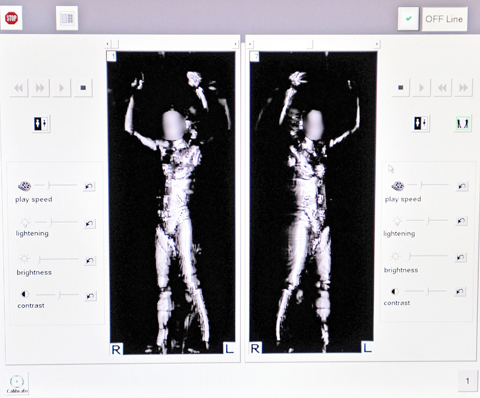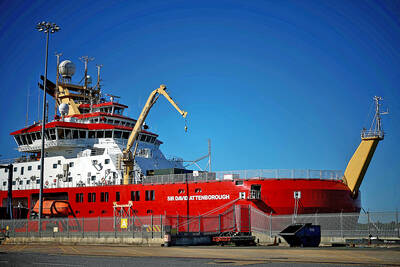As US lawmakers demand to know how a would-be attacker smuggled explosives aboard a plane on Christmas Day, the use of body scanners at airport security points is likely to be revisited.
The machines are considered effective and have been tested at numerous international airports, but they are also controversial because they scan beneath clothing to detect items that may be hidden from ordinary view.
Security experts believe that the scanners could have detected the explosives that Umar Farouk Abdulmutallab was hiding as he boarded a Northwest Airlines plane in Amsterdam last week.

PHOTO: AFP
Abdulmutallab attempted to bring down the Airbus 330 by combining a flammable liquid he was carrying in a syringe with an explosive powder known as pentaerythritol (PETN) that was sewn into his underwear.
The metal detectors that passengers ordinarily step through as their luggage is being X-rayed would not have detected either component, experts said.
In the wake of the failed attack, British Interior Minister Alan Johnson said on Monday he would consider installing full body scanners at British airports “as quickly as possible.”
In the US, the scanners are already used at 19 airports and a handful of courthouses and prisons, the US Transportation Security Administration says.
The machines look like small booths and use radio frequencies to scan underneath clothing and produce a 3D image of the individual’s body.
While the scanner does not produce an image of the naked body, it has caused consternation among privacy advocates because it does faithfully reproduce individual curves hidden beneath clothing, from the shape of a breast to a roll of fat.
The device has been tested in numerous European airports, but its use was halted after the EU expressed concerns and protested a plan to install the scanners at airports throughout the EU.
EU representative Martine Roure praised the mothballing of the project, saying it would have been “disproportionate to submit all passengers to this type of check in the name of the fight against terrorism.”
But Thursday’s failed attack could prompt lawmakers worldwide to change their minds about the body scanners.
Successful and failed terror attacks targeting airplanes have already led to significant changes to the way people fly.
After the Sept. 11, 2001, attacks, pilots began locking the cockpit door behind them to prevent hijackers from accessing the flight controls.
In the wake of Richard Reid’s failed December 2001 attempt to detonate explosives in his shoes, passengers now routinely submit their footwear to inspection before boarding a plane.
And after authorities uncovered a plot in 2006 to blow up airliners with explosives in liquid containers, new regulations were imposed limiting the amount of fluid each traveler could bring aboard a flight.
Bruce Hoffman, a terrorism expert at Georgetown University, told reporters that traditional security measures simply would not be able to detect the sort of explosive Abdulmutallab was carrying.
“There is no other way, except for a body scan, to detect it,” he said.
Even the secondary screening measures sometimes used at airports would have failed, he said.
“If [if the explosive PETN] was sealed extremely tight in plastic, dogs wouldn’t have picked it up,” he said.
Douglas Laird, a former security director for Northwest Airlines, agreed, noting it was virtually impossible to know what was beneath clothing without the scanners.
But some are more skeptical about the efficacy of the machines, including Jimmie Carol Oxley, the co-director of the Center of Excellence in Explosive Detection, Mitigation, Response and Characterization at the University of Rhode Island.
“Anything is hard to detect if you’re not looking for it,” he pointed out, noting that airport security already has machines that can detect PETN. “If you go through the airport and they ever pull you over for your carry-on and they swab your carry-on, they can pick up that, those machines detect it.”
The machines also come with another problem: They cost around US$1 million, 20 times more than a standard X-ray machines, Laird said.

STEPPING UP: Diminished US polar science presence mean opportunities for the UK and other countries, although China or Russia might also fill that gap, a researcher said The UK’s flagship polar research vessel is to head to Antarctica next week to help advance dozens of climate change-linked science projects, as Western nations spearhead studies there while the US withdraws. The RRS Sir David Attenborough, a state-of-the-art ship named after the renowned British naturalist, would aid research on everything from “hunting underwater tsunamis” to tracking glacier melt and whale populations. Operated by the British Antarctic Survey (BAS), the country’s polar research institute, the 15,000-tonne icebreaker — boasting a helipad, and various laboratories and gadgetry — is pivotal to the UK’s efforts to assess climate change’s impact there. “The saying goes

Police in China detained dozens of pastors of one of its largest underground churches over the weekend, a church spokesperson and relatives said, in the biggest crackdown on Christians since 2018. The detentions, which come amid renewed China-US tensions after Beijing dramatically expanded rare earth export controls last week, drew condemnation from US Secretary of State Marco Rubio, who on Sunday called for the immediate release of the pastors. Pastor Jin Mingri (金明日), founder of Zion Church, an unofficial “house church” not sanctioned by the Chinese government, was detained at his home in the southern city of Beihai on Friday evening, said

Floods on Sunday trapped people in vehicles and homes in Spain as torrential rain drenched the northeastern Catalonia region, a day after downpours unleashed travel chaos on the Mediterranean island of Ibiza. Local media shared videos of roaring torrents of brown water tearing through streets and submerging vehicles. National weather agency AEMET decreed the highest red alert in the province of Tarragona, warning of 180mm of rain in 12 hours in the Ebro River delta. Catalan fire service spokesman Oriol Corbella told reporters people had been caught by surprise, with people trapped “inside vehicles, in buildings, on ground floors.” Santa Barbara Mayor Josep Lluis

TICKING CLOCK: A path to a budget agreement was still possible, the president’s office said, as a debate on reversing an increase of the pension age carries on French President Emmanuel Macron yesterday was racing to find a new prime minister within a two-day deadline after the resignation of outgoing French Prime Minister Sebastien Lecornu tipped the country deeper into political crisis. The presidency late on Wednesday said that Macron would name a new prime minister within 48 hours, indicating that the appointment would come by this evening at the latest. Lecornu told French television in an interview that he expected a new prime minister to be named — rather than early legislative elections or Macron’s resignation — to resolve the crisis. The developments were the latest twists in three tumultuous